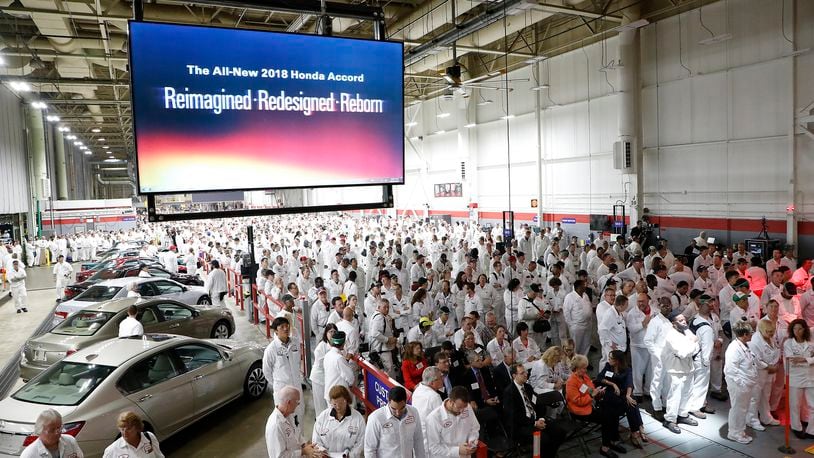The project would entail a commitment by Honda of America Mfg. Inc. to invest $200 million and create 120 new jobs with an attendant new payroll of $5,304,000.
Retained would be 2,367 current jobs, according to a JobsOhio summary of the project.
“Honda is preparing for the future at our engine plant in Anna, building on 35 years of continued investment in our operations and the capabilities of the approximately 3,000 associates who now work there,” a Honda spokesman said. “Based on the investment of nearly $3 billion in the Anna facility to date, (the plant has) produced engines powering more than 30 million cars and light trucks made in Ohio, while also serving as a catalyst for additional investment and employment in the state.”
A JobsOhio spokesman Monday referred questions to Honda, but welcomed general news of the investment.
Located about an hour’s drive north of Dayton, the Anna plant in Shelby County has operated since 1985, growing from 100 workers into what Honda says is its second largest Ohio operation, employing more than 2,800 people.
Before the pandemic, the Anna plant produced more than 1 million four-cylinder, V-6 and turbo engines for Honda auto plants across North America. In addition, the plant also produces pulleys for Continuously Variable Transmissions used in the Honda Accord and CR-V.
Meanwhile, a global shortage of automotive semiconductors is being felt in Ohio and other places in North America.
“Honda is cutting production of its Civic and Accord sedans by roughly 2,200 cars this week in North America, down roughly a fifth from what had been originally scheduled,” the Wall Street Journal reported Sunday, citing unnamed executives for U.S.-based suppliers to Honda.
In North America, the Honda Accord is built at the automaker’s four million-square-foot Marysville, Ohio assembly plant, while the Civic is built in Greensburg, Ind. The Civic is also built at an Ontario plant.
“This is a fluid situation and we will share updates at the appropriate time,” a Honda spokesman said Sunday.
A spokesman last week acknowledged that company leaders were looking at the matter but did not say whether the situation was affecting Ohio plants directly.
Automakers are scrambling, but eventually, the semiconductor pipeline will be filled, predicted Michelle Krebs, senior director of automotive relations for Cox Automotive and executive analyst for Autotrader. (Cox Automotive Inc. is part of Cox Enterprises, which owns this newspaper.)
Part of the reason for the shortage, which really began last year, was the stronger-than-expected rebound in demand for automobiles, Krebs said.
Honda for December reported monthly sales of 136,467, only 99 vehicles down from December 2019. It ended 2020 with sales of 1.34 million cars and light trucks, down 16% from 2019.
Another reason for the semiconductor pinch: Sales of computers have grown during the pandemic, creating demand in other market sectors.
It’s a classic supply-and-demand dilemma, said David Kudla, a Dayton native, University of Dayton graduate and chief executive of Grand Blanc, Mich.-based Mainstay Capital Management.
“Last year, when automotive plants were shut down as a result of the pandemic, many semiconductor makers diverted production to computers and consumer electronics, as the stay-at–home economy created surging demand,” Kudla said.
“In the past months, automotive sales have recovered faster than expected, creating renewed demand,” he added.
It is now a matter of refilling the pipeline, which is a matter of time, Kudla added.
Production in Marysville has been slowed before. In April 2019, Honda acknowledged plans to shut down a second-shift production line at its Marysville plant starting that summer for a few years — a move that Honda said would not result in worker layoffs.
At the time, a Honda spokeswoman cited the shift of market demand from sedans to SUVs and light trucks.
2020 was a challenging year for Honda and other automakers.
Nearly all North American auto plants ceased production in March, as the pandemic tightened its grip. In April, for the first time in Honda’s history in Ohio, the company was forced to lay off workers.
In mid-May Honda began to gradually resume auto, engine and transmission production in its U.S. and Canadian plants, ending a suspension of production that had started March 23.
And over the summer, the automaker also acknowledged that worker absenteeism and other challenges forced front-office and administrative workers to temporarily handle assembly line and production work.
About the Author
